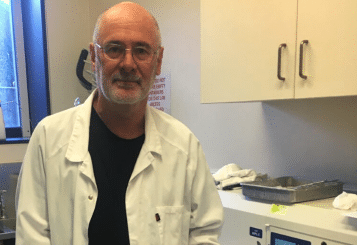Professor Roger Byard AO PSM founded Red Nose’s National Scientific Advisory Group, together with Jan Carey, in 2004 after a ground breaking meeting in Canberra that set the first nationally accepted definition of SIDS. He is also Chair of Pathology at The University of Adelaide and Senior Specialist Forensic Pathologist at Forensic Science South Australia. Here Professor Byard describes the evolution and future of SIDS research and what motivates him to keep looking for answers.
I worked in a variety of paediatric settings in clinical medicine for several years before I started training in pathology in Ottawa Canada.
I have always been interested in children’s issues and I became attracted to paediatric pathology because of the supreme importance of child health.
I remember my first paediatric autopsy patient very well. It was 1984 and a little girl had died of cancer – her name was Genevieve.
No parent should ever have to see their child die and so I have worked for many years to help understand and prevent a wide variety of lethal diseases and conditions.
This research has led to many scientific papers and four text books on paediatric forensics and Sudden Infant Death Syndrome (SIDS).
In the past we considered SIDS to be a disease with a single cause. Nowadays we understand that it is really the end result of the interaction of certain babies with their environments.
This is very well summarized in the “triple risk” model which says that certain vulnerable babies exposed to environmental hazards, such as sleeping face down and cigarette smoke, particularly between the ages of 2-4 months, are at increased risk of sudden death.
By understanding that SIDS is a complicated disorder composed of a number of distinct subgroups of babies, we have been able to understand it better and take very successful steps to reduce the number of these tragic deaths.
Currently, SIDS rates vary greatly among countries, but we have seen a very satisfying fall in numbers in Australia from around 2-3 deaths per 1000 live babies to around 0.1 per 1000 babies – which is around 24 deaths a year today.
To give a local example from South Australia, the annual number of deaths in the 1980s was more than 50 per year compared to just 1-2 deaths per year now.
While it is likely that certain genetic factors play a role in contributing to some SIDS deaths, we do know that there is no “SIDS gene”.
Repeated deaths in a family could well be due to genetic factors, but these are more likely to be inherited cardiac conditions or a rare metabolic illnesses. Following siblings may be at an increased risk, but this is mainly if environmental factors such as exposure to cigarette smoke are not modified.
The next important area of SIDS research involves studying the brainstem – the part of the brain that controls our breathing and heart rate.
Exciting research in this area in recent years has focused on a chemical called serotonin which appears to be reduced in certain SIDS babies. This means that they are not able to respond to environmental challenges as quickly or as well as normal babies.
Perhaps even more exciting is our own work in collaboration with Harvard University looking at a chemical called substance P. We have found that this can be significantly reduced in areas of the brainstem that control head and neck movement.
This could explain why babies who die of SIDS in the face down position have not just moved their heads to a safer position on the side – they may have been not be able to.
The future of research will involve examining brainstem chemicals more clearly and determining whether deficiencies are linked to genetic markers.
It may then be possible to test for these specific genetic defects in babies to help us identify those who have a much higher risk of SIDS.
My work is greatly rewarding and I was very honoured to receive the International Distinguished Researcher Award from the International Society for the Study and Prevention of Perinatal and Infant Death (ISPID) in 2016 for outstanding contributions to SIDS research.
As a researcher, I find contact with families is vital so that they have the chance to ask questions and talk to the doctor who looked after their baby or child after their passing.
I had a mother contact me a couple of years ago to talk about her daughter who had died 25 years previously. This type of interaction makes my work so worthwhile.
For over 30 years now, I have been associated with Red Nose (formerly SIDS and Kids) at state and national levels as a researcher, pathologist, advisor, and counsellor to families.
It has been one of the very great privileges of my professional life to be associated with Red Nose and all its associated people who have genuinely, consistently and very generously committed so much of their time and passion to this cause. Thank you all so much for this experience.
Did you find this helpful?
Good job! Please give your positive feedback
How could we improve this post? Please Help us.
